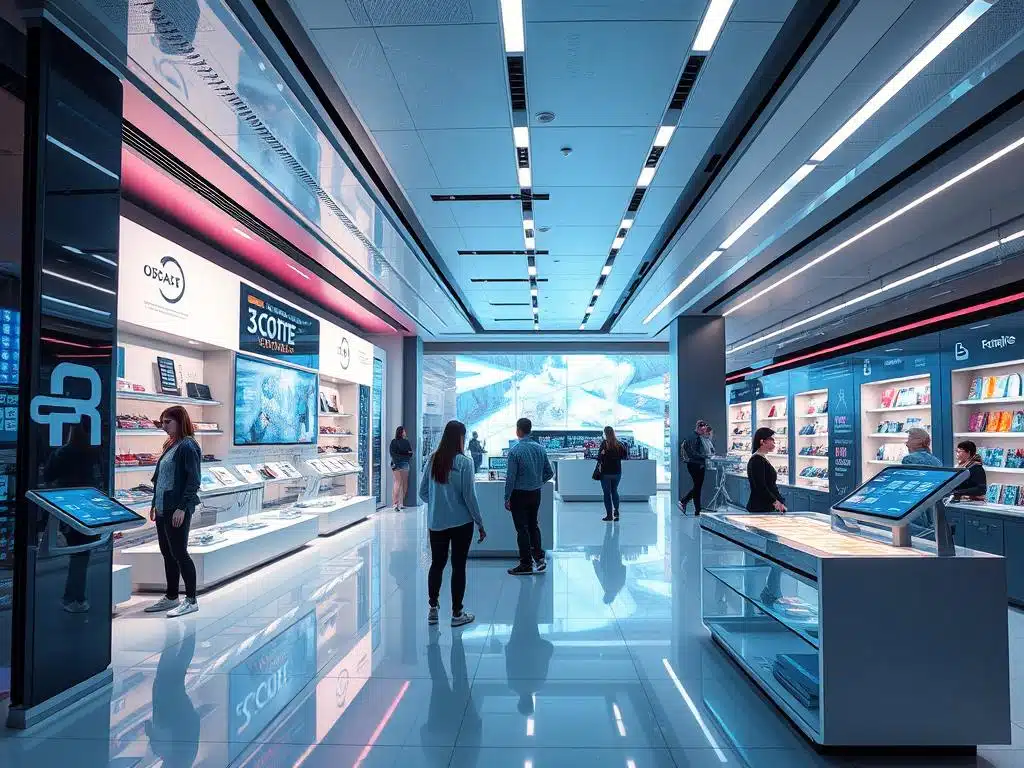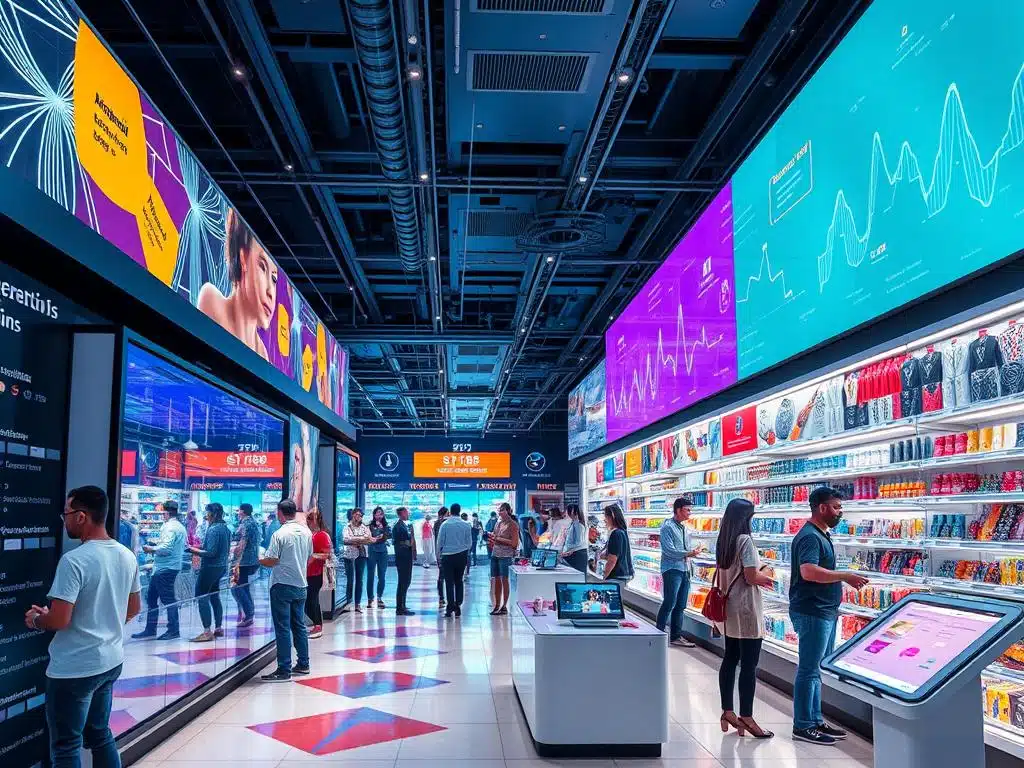The retail landscape is evolving rapidly, driven by cutting-edge technologies and shifting consumer expectations digital transformation strategies for retail. By 2025, the global digital transformation market may hit $1,009.8 billion. This represents a 16.5% compound annual growth rate. Retailers must innovate to stay competitive in this dynamic environment.
We’ll explore key digital transformation strategies for retail success in 2025 and beyond. These include tech-driven sustainability and fully integrated AI. IDC predicts AI will be part of 90% of new enterprise applications by 2025.
Cloud computing and multi-layered cybersecurity are crucial for scalability, flexibility, and data protection. The cloud security market is expected to grow from $40.7 billion in 2023 to $62.9 billion by 2028. This represents a 9.1% compound annual growth rate. Investing in robust cybersecurity will be a top priority for retailers.
Digital transformation isn’t just about new technologies. It requires a fundamental shift in mindset and culture. Retailers must foster continuous learning and innovation to stay relevant. Embracing these strategies can unlock growth opportunities and enhance customer experiences.
Key Takeaways
- Embrace tech-driven sustainability to lower environmental impact and increase profitability
- Harness the power of fully integrated generative and analytical AI for personalized experiences and operational efficiency
- Adopt the Everything as a Service (XaaS) model to transform retail operations and develop subscription-based pricing models
- Implement multi-layered cybersecurity measures to protect sensitive data and maintain customer trust
- Enhance omnichannel customer experiences through AI-powered personalization and seamless online-offline transitions
Embracing Tech-Driven Business Sustainability
The retail landscape is evolving rapidly. E-commerce integration and tech-driven sustainability are now essential for success. Digital transformation strategies that reduce environmental impact align with consumer values. These strategies increase profitability, boost ESG scores, and attract socially conscious investors.
Lowering Environmental Impact and Increasing Profitability
Eco-friendly initiatives can significantly lower a retailer’s environmental footprint. Smart shelf management reduces food waste. Energy-efficient cloud services minimize resource consumption. Hanshow’s Electronic Shelf Label solution has a 15-year battery life.
Their Smart Shelf Management system reduced product out-of-stock duration by 40%. These technologies help retailers minimize waste and boost their bottom line. Implementing such solutions can lead to substantial cost savings and improved efficiency.
Leveraging ESG Scores for Enhanced Shareholder Value
Investors prioritize companies with strong environmental, social, and governance practices. Retailers committed to sustainability attract more investment and enhance shareholder value. Setting and achieving ambitious sustainability targets improves ESG scores. This positions retailers as industry leaders in responsible business practices.
“Three-quarters of Gen Z consumers consider sustainability more important than brand when making a purchase decision.”
Aligning with Consumer Values Through Eco-Friendly Initiatives
Younger generations are increasingly concerned about the environmental impact of their purchases. Implementing eco-friendly initiatives aligns retailers with their target audience’s values. Electronics recycling programs and zero-waste policies demonstrate commitment to sustainability. This alignment fosters customer loyalty and enhances employee engagement.
Tech-driven sustainability is a strategic necessity in retail’s future. Prioritizing environmental impact reduction and leveraging ESG scores are crucial. Aligning with consumer values positions retailers for long-term success. This approach is vital in an increasingly competitive and socially conscious market.
Harnessing the Power of Fully Integrated Generative and Analytical AI
Integrating generative and analytical AI across the enterprise is vital for retailers’ digital transformation. This holistic approach unlocks immense value and drives sustainable growth. Generative AI could boost retail’s economic value by $240-$390 billion. Industry-wide adoption may increase margins by 1.2-1.9 percentage points.
Moving from Localized AI Use Cases to Enterprise-Wide Integration
Only two of over 50 surveyed retail executives have implemented generative AI organization-wide. Retailers must adopt an enterprise-wide approach, integrating generative AI and analytical AI into core processes. This integration can drastically improve operational efficiency.
Retailers using AI copilots have seen up to 60% reduction in software engineering task time. This demonstrates the potential for significant productivity gains across various departments.
Exploring the Potential of Generative AI in Retail Applications
Generative AI offers diverse retail applications, from personalized marketing campaigns to product recommendations and customer service. Amazon’s AI-powered image generation tool has increased advertising click-through rates by 40%. Generative AI chatbots boost customer engagement throughout the entire journey.
Utilizing Analytical AI for Trend Prediction and Inventory Optimization
Analytical AI enables retailers to make data-driven insights and optimize operations. Advanced analytics and machine learning algorithms help predict trends, forecast demand, and optimize inventory levels. AI-driven decision-making can increase incremental sales by 5% and improve EBIT margins by 0.2-0.4 percentage points.
| Benefit | Percentage |
|---|---|
| Retailers experiencing boosted annual revenue after adopting AI | 69% |
| Retailers seeing a significant decrease in operating costs following AI adoption | 72% |
Streamlining Processes with Intelligent Automation
Intelligent automation is crucial for AI integration in retail. It enhances efficiency by automating repetitive tasks and streamlining processes. Innovative generative AI solutions can transform the entire retail value chain.
This includes marketing, commercialization, distribution, and back-office operations. These advancements free up valuable resources for more strategic initiatives.
The AI retail market is anticipated to reach $85.07 billion by 2032 according to Fortune Business Insights.
Adopting the Everything as a Service (XaaS) Model
The Everything as a Service (XaaS) model is vital for retailers in today’s digital landscape. XaaS offers reduced infrastructure costs, scalability, and access to cutting-edge technology. This makes it attractive for businesses aiming to stay competitive in retail.
Companies shifting to XaaS models are seeing significant success. Consumers and investors are rewarding those who adopt this approach. Newer companies launching with as-a-Service models have an edge over traditional counterparts.
The XaaS Market was valued at $559.14 billion in 2022. It’s forecasted to grow to $3,221.96 billion by 2030. This represents a compound annual growth rate (CAGR) of 24.4%.
Assessing Retail Operations for Service Transformation Opportunities
Retailers must assess their operations to identify areas for service transformation. This involves evaluating existing systems, processes, and offerings. The goal is to determine where XaaS can be most effectively applied.
A thorough assessment helps retailers pinpoint opportunities to streamline operations. It also aids in reducing costs and enhancing the customer experience.
Developing Subscription-Based Pricing Models
A key aspect of XaaS is adopting subscription-based pricing. This approach allows retailers to offer products and services on a recurring basis. It provides steady revenue and fosters long-term customer relationships.
Retailers can encourage loyalty by developing attractive subscription packages. These should be tailored to their target audience. This strategy can increase customer lifetime value.
Around 55% of respondents in the IT sector invested in one or more types of Everything as a Service (XaaS) model during the COVID-19 pandemic, as per a Deloitte Insights Survey conducted in 2021.
Investing in Customer Success and Retention Strategies
To maximize XaaS benefits, retailers must prioritize customer success and implement effective retention strategies. This involves providing exceptional support and continuously improving the customer experience. Proactively addressing issues is also crucial.
Investing in customer success initiatives can reduce churn and increase satisfaction. This ultimately drives long-term growth for retailers.
Adopting XaaS is becoming essential for retail success in the digital age. Retailers can position themselves for future success by focusing on key strategies. These include service transformation, subscription pricing, and customer retention.
Implementing Multi-Layered Cybersecurity Measures
Retailers face numerous cyber threats in today’s digital world. These include phishing attacks, ransomware, data breaches, and insider threats. A multi-layered approach to cybersecurity is essential to combat these risks effectively. This strategy should encompass AI-powered security, employee training, zero-trust architecture, cloud security, and IoT security.
A holistic strategy addressing technology, people, processes, and culture strengthens our defenses. It safeguards our valuable data assets against potential breaches. Protection against lateral movement attacks is crucial in our cybersecurity measures.
Microsegmentation and network segmentation limit an attacker’s ability to move within our systems. Application security requires regular code reviews, penetration testing, and firewalls. These practices help identify and address vulnerabilities before exploitation.
Data security is vital in our multi-layered approach. We must implement data encryption, secure key management, and data loss prevention software. Strict access controls ensure sensitive information remains confidential and protected.
Identity and access management (IAM) features, like zero-trust architecture, continuously verify user identities and permissions. This minimizes the risk of unauthorized access to our systems. Technological solutions are crucial, but we must not overlook the human element in cybersecurity.
Investing in comprehensive security awareness training for employees is essential. Educating staff on best practices, such as identifying phishing attempts, creates a culture of vigilance. This reduces the likelihood of successful attacks against our organization.
“Cybersecurity is not just about technology; it’s about people, processes, and culture. By fostering a security-minded workforce, we can significantly enhance our overall defense posture.” – Jane Doe, Chief Information Security Officer
No organization is immune to cyber incidents. A well-defined incident response plan is crucial for effective cybersecurity management. Clear protocols for detecting, containing, and recovering from attacks minimize breach impact and ensure business continuity.
The cybersecurity landscape statistics are sobering:
- 54% of organizations have experienced an incident involving industrial control systems.
- Ransomware attacks on the manufacturing sector have increased by 156%.
- 81% of malware could disrupt industrial control systems.
- The average cost of a cyberattack for companies in 2021 was over $4 million.
- On average, organizations require 295 days to detect and contain a cyberattack.
By embracing a multi-layered approach to cybersecurity, we can proactively address these challenges and safeguard our retail operations from the ever-evolving threat landscape.
Enhancing Omnichannel Customer Experience
Delivering an exceptional omnichannel customer experience is crucial in today’s retail landscape. Consumers expect seamless interactions across multiple channels. A McKinsey survey reveals that 60-70% of respondents use various online and offline channels for research and purchases.
Leveraging AI and Data Analytics for Hyper-Personalization
Retailers must harness AI and data analytics to deliver personalized shopping experiences. Analyzing customer data across touchpoints provides valuable insights into individual preferences. This enables hyper-personalized product recommendations and targeted promotions.
Salesforce reports that 39% of consumers are likely to spend more after experiencing personalized shopping across multiple channels.
Ensuring Seamless Transitions Between Online and Offline Touchpoints
Creating a unified brand experience across all channels is essential. This includes integrating digital and physical touchpoints. Retailers can allow customers to browse online and pick up in-store or offer virtual consultations.
Safari Digital reveals that 43% of users conduct online searches from smartphones while in-store. This emphasizes the need for a cohesive omnichannel approach.
“Businesses offering omnichannel experiences see a 91% higher year-over-year customer retention rate compared to those who do not.” – Aberdeen Group
Focusing on Friction-Free, Memorable Customer Interactions
Retailers must prioritize friction-free, memorable customer interactions to foster loyalty. This involves streamlining processes, reducing wait times, and providing effective support across all channels. Leveraging technologies like chatbots and mobile apps can enhance customer experiences.
Omnisend reports that omnichannel campaigns have a 287% higher purchase rate than single-channel campaigns. This underscores the importance of a well-executed strategy.
| Channel | Customer Engagement | Conversion Rate |
|---|---|---|
| In-Store | 78% of location-oriented online searches lead to in-store purchases | 45% |
| Mobile Apps | Substantial growth in mobile market, indicating increasing consumer engagement | 60% |
| Social Media | People spend approximately 2.5 hours daily on social media (38% of online time) | 55% |
Embracing these strategies and leveraging technology can enhance omnichannel customer experiences. This drives customer loyalty and achieves long-term success in the evolving retail landscape of 2025 and beyond.
Optimizing Supply Chain Management with Digital Tools
Digital tools are revolutionizing supply chain management in retail. These innovations streamline processes, boost visibility, and enhance efficiency. Digital transformation is reshaping business models and promoting data-driven decisions.
Digital supply chains offer real-time data analytics, providing predictive insights into market changes. This allows retailers to anticipate issues and respond swiftly to demand fluctuations. Research shows digital transformation can halve process costs and boost revenue by 20%.
Implementing Real-Time Inventory Tracking and Forecasting
Traditional supply chains often face 48-hour delays in updating inventory systems. Real-time tracking ensures accurate stock levels, preventing overstocking or stockouts. IoT devices and cloud computing enable seamless communication across the supply chain.
Predictive analytics forecasts disruptions and demand spikes. Domino’s® uses data analytics to track delivery times and customer ratings. Advanced analytics help businesses make informed decisions and optimize inventory management.
Utilizing AI for Predictive Maintenance and Risk Mitigation
AI revolutionizes supply chain management through predictive maintenance and risk mitigation. Automation technologies reduce downtimes and errors in manufacturing and logistics processes. AI predicts equipment failures and schedules proactive maintenance, minimizing supply chain disruptions.
AI also identifies and mitigates risks by monitoring factors like weather patterns and supplier performance. This enables retailers to develop contingency plans and build a more resilient supply chain.
| Benefit | Description |
|---|---|
| Enhanced Visibility | Real-time tracking and monitoring of inventory, shipments, and supplier performance |
| Increased Efficiency | Streamlined processes, reduced manual tasks, and improved accuracy |
| Improved Insights | Data-driven decision-making based on advanced analytics and predictive modeling |
| Agility | Ability to quickly adapt to market changes and customer demands |
93% of organizations surveyed in 2023 by IDG’s Foundry unit said they had adopted or planned to adopt a “digital-first” strategy.
Successful digital transformation requires assessing current processes and centralizing analytics capabilities. Investing in talent development is crucial. Clear objectives and prioritized technologies enhance visibility, efficiency, and collaboration across the supply chain.
Investing in Mobile App Development and Personalized Marketing
Retailers must adapt to meet smartphone users’ expectations for seamless, tailored shopping experiences. Mobile app development and personalized marketing are crucial strategies for engaging customers and boosting sales. These approaches help businesses thrive in the rapidly changing retail landscape.
Studies reveal that 63% of smartphone users prefer purchasing from companies with personalized product recommendations in their apps. Half of the installed shopping apps are used weekly. This data underscores the need for user-friendly and engaging mobile applications.
By 2026, eCommerce industry sales are expected to exceed $8.1 trillion. Retailers must prioritize mobile app development to capture a significant market share. AI and ML-powered apps can deliver personalized experiences and intelligent recommendations, enhancing customer satisfaction and loyalty.
Mobile apps are vital for customer service, with 78% of consumers using mobile devices for brand support. This statistic highlights the importance of investing in robust and responsive mobile app features for retailers.
IoT-integrated mobile apps enhance real-time tracking and operations across various industries for B2B and B2C markets. Global spending on digital transformation is projected to reach $3.9 trillion by 2027. To stay competitive, retailers must focus on mobile app development and personalized marketing campaigns.
Leveraging Data-Driven Insights for Strategic Decision Making
Data-driven insights are crucial for success in today’s retail landscape. Advanced analytics and predictive modeling help retailers make informed decisions. These tools drive growth, improve customer experiences, and enhance operational efficiency. Data-driven practices provide a distinct competitive edge, with 86% of executives agreeing.
Utilizing Advanced Analytics for Customer Segmentation and Targeting
Advanced analytics tools enable retailers to segment customers based on behaviors, preferences, and demographics. This understanding allows for targeted marketing campaigns and personalized experiences. Consider these statistics:
- 71% of consumers expect personalized interactions from companies, with three-quarters willing to switch brands if the experience is not personalized.
- Companies leveraging data are 23 times more likely to acquire customers, six times more likely to retain them, and 19 times more likely to be profitable.
Harnessing the Power of Predictive Analytics for Demand Forecasting
Predictive analytics helps retailers forecast demand accurately and optimize inventory levels. It also streamlines supply chain operations. By analyzing sales data, market trends, and external factors, retailers can make informed decisions.
These decisions minimize stockouts and maximize profitability. Here are some compelling findings:
| Benefit | Impact |
|---|---|
| Improved forecast accuracy | 30% improvement compared to traditional methods |
| Optimized inventory levels | Analyzing demand patterns, lead times, and supplier performance |
| Reduced days sales outstanding (DSO) | Assessing customer payment behaviors and credit risks |
Companies using advanced analytics for strategic decision-making were twice as likely to be in the top quartile of financial performance in their industries, according to a Bain & Company study. Data-driven insights help retailers stay ahead of the curve and adapt to market changes.
Digital Transformation Strategies for Retail: The Key to Success in 2025
Embracing digital transformation strategies is crucial for retail survival and growth. Retailers must prioritize continuous learning and innovation while adapting to new technologies and market trends. This approach unlocks growth opportunities and drives sustainable success in a competitive environment.
High-growth retailers invest significantly more in IT budgets than competitors. They’re also more likely to use third-party services for hardware refreshes and managed services. This highlights the importance of technology investment and external expertise for staying competitive.
Fostering a Culture of Continuous Learning and Innovation
Thriving retailers cultivate a culture of continuous learning and innovation. They provide tools and resources for skill development and idea exploration. Empowering teams to experiment and learn from failures fosters growth and adaptability.
Regular training programs on emerging technologies and best practices promote continuous learning. Encouraging cross-functional collaboration breaks down silos and facilitates idea exchange. These strategies help retailers stay agile in the digital age.
Adapting to Emerging Technologies and Market Trends
Staying competitive requires keeping up with emerging technologies and market trends. Retailers should invest in research, attend industry conferences, and collaborate with tech partners. This approach helps explore new possibilities and stay ahead of the curve.
Key focus areas for retailers in 2025 may include:
- AI-powered personalization and recommendation engines
- Augmented reality (AR) and virtual reality (VR) for immersive shopping experiences
- Internet of Things (IoT) for real-time inventory tracking and supply chain optimization
- Blockchain technology for secure and transparent transactions
Proactively integrating these trends into digital transformation strategies for retail helps differentiate businesses. It enables retailers to deliver exceptional customer experiences and stay ahead of competitors.
| Digital Transformation Initiative | Potential Impact |
|---|---|
| AI-powered personalization | Increased customer engagement and loyalty |
| AR/VR shopping experiences | Enhanced product visualization and reduced returns |
| IoT for inventory management | Improved operational efficiency and reduced costs |
| Blockchain for secure transactions | Increased trust and transparency in the supply chain |
Digital transformation is an ongoing process of improvement and adaptation. Embracing learning, innovation, and agility helps retailers navigate challenges and opportunities. This approach positions them as leaders in the evolving digital retail landscape.
Conclusion
By 2025, digital transformation strategies for retail will be crucial for success in the tech-driven market. Online spending is projected to exceed 50% by 2024, with 60% via mobile devices. Retailers must adapt to meet evolving customer needs and preferences.
AI, cloud services, and advanced analytics can enhance customer experiences and optimize operations. These technologies enable personalized omnichannel experiences, real-time inventory tracking, and automated checkout systems. Implementing these strategies requires a culture of continuous learning and innovation.
Advantech Digital helps retailers navigate this transformative journey. Our experts are dedicated to ensuring long-term success for our clients. The retail and digital transformation market is expected to grow significantly.
Projections show an increase from $0.71 trillion in 2023 to $1.72 trillion by 2028. This represents a remarkable CAGR of 19.30%. Retailers should embrace digital transformation now to secure future success.
FAQ
What are the key digital transformation strategies for retail success in 2025?
Retailers must embrace tech-driven sustainability and fully integrated AI for success in 2025. XaaS models and multi-layered cybersecurity are crucial components. Exceptional omnichannel customer experiences should be a primary focus. Data-driven insights and optimized supply chain management are vital for growth.
Mobile app development and personalized marketing campaigns are essential investments. These strategies will help retailers stay competitive and drive growth in the coming years.
How can retailers lower their environmental impact while increasing profitability?
Implementing eco-friendly initiatives like electronics recycling programs and zero-waste policies can lower environmental impact. Aligning with consumer values helps increase profitability and enhance shareholder value through improved ESG scores. These efforts also boost employee engagement and strengthen brand reputation.
What role does AI play in the digital transformation of retail?
Retailers should integrate AI enterprise-wide, moving beyond localized use cases. Generative AI creates personalized content, while analytical AI predicts trends and optimizes inventory. Intelligent automation streamlines processes and enhances operational efficiency. AI-powered recommendations and personalization significantly improve customer experiences.
What are the benefits of adopting the Everything as a Service (XaaS) model in retail?
XaaS offers decreased infrastructure costs, scalability, and access to cutting-edge technology. Assessing operations for service transformation opportunities is crucial. Developing subscription-based pricing models and investing in customer retention strategies are key. These steps help retailers adapt to the XaaS landscape and drive growth.
How can retailers protect themselves against cyber threats in the digital age?
Retailers must adopt a multi-layered approach to cybersecurity due to increasing digital entry points. This includes AI-powered security, employee training, and zero-trust architecture. Cloud security and IoT protection are also essential. A holistic strategy addressing technology, people, processes, and culture ensures effective protection.
What strategies can retailers use to optimize their supply chain management?
Digital tools enable real-time inventory tracking, forecasting, and AI-powered predictive maintenance. These technologies help mitigate risks and optimize supply chain management. Resilient and agile supply chains are crucial for adapting to market disruptions and changing consumer demands.
How can data-driven insights help retailers make strategic decisions?
Retailers must leverage data-driven insights for strategic decision making and customer segmentation. Advanced analytics enable targeted marketing and improved customer experiences. Predictive analytics help forecast demand and anticipate market trends. These strategies optimize marketing efforts and drive business growth.
What mindset should retailers adopt to successfully navigate digital transformation?
Successful digital transformation requires a culture of continuous learning and innovation. Retailers must adapt to emerging technologies and market trends quickly. Viewing transformation as an ongoing journey unlocks new growth opportunities. This mindset drives sustainable success in the ever-evolving retail landscape.

















3 thoughts on “Top Digital Transformation Strategies for Retail Success in 2025”
Comments are closed.